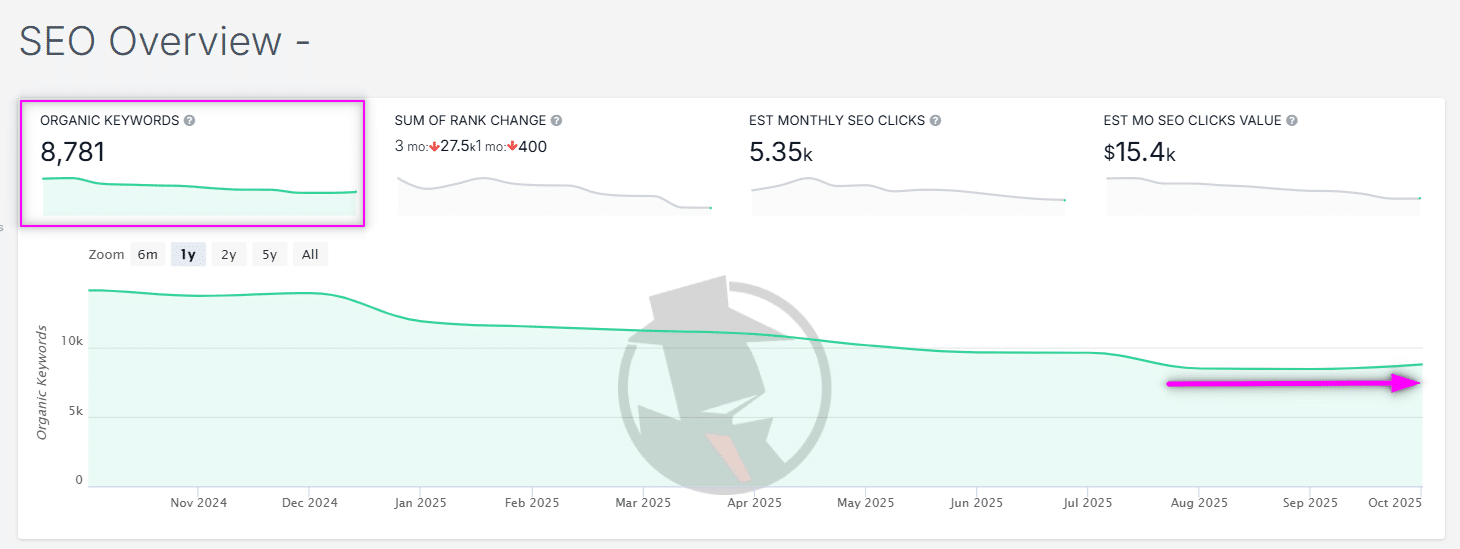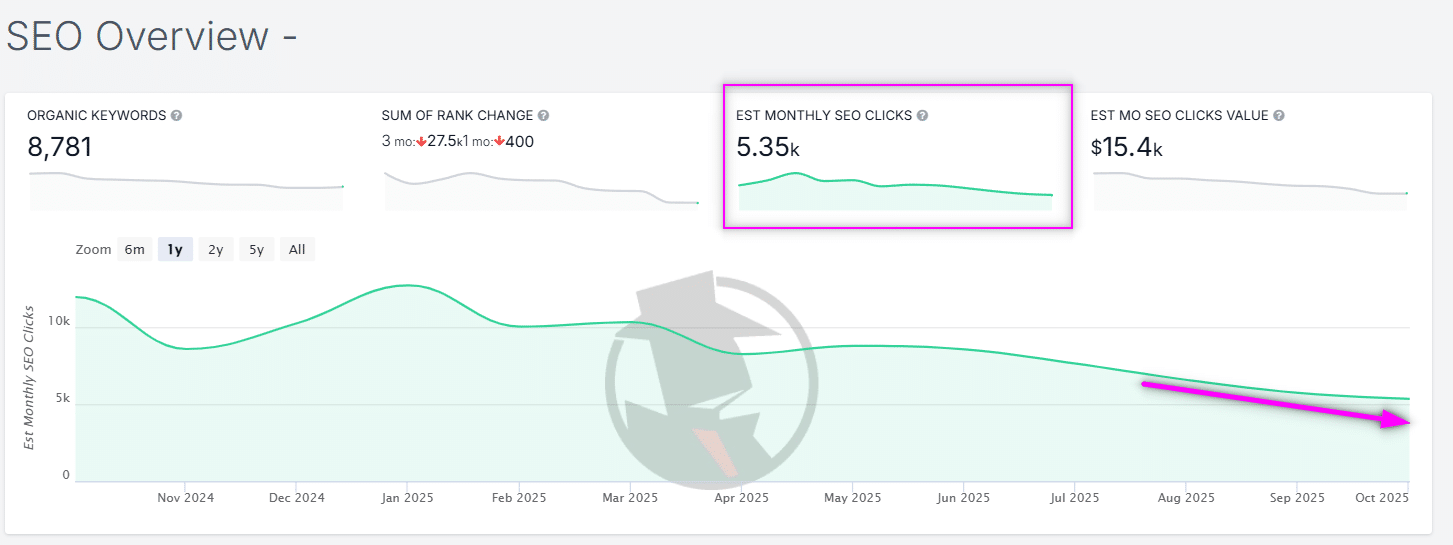Lessons from SpyFu Data and the Rise of GEO: Why Organic Keyword Rankings Are Your Best Bet for SEO Success
Search engine optimization (SEO) is always changing, and data doesn’t lie, but it does whisper before it shouts. Organic keyword rankings can often give you a clear picture of where your traffic is going, acting as a silent harbinger of future organic visitors.
A lot of marketers focus on short-term traffic spikes or conversion rates, but smart SEO experts know that tracking changes in your site’s rank month over month can tell you how well your site is doing long before visitor numbers catch up.
This article goes into great detail about that dynamic, using real data from SpyFu, a reliable competitive intelligence tool, to make its point. We’ll look at a snapshot of a website’s SEO performance, where keyword rankings that stay the same mean that organic traffic will soon stabilize.
More importantly, we’ll talk about why putting SEO rankings first isn’t just a good idea; it’s a must in 2025, especially as AI-driven search changes the game. Welcome to Generative Engine Optimization (GEO), the new frontier where getting a good ranking means optimizing not just for Google, but also for AI chatbots like ChatGPT, Perplexity, and Grok that are becoming more and more common.
If you’re a business owner, content strategist, or digital marketer who wants to know how to keep your traffic coming in the future, keep reading. This isn’t just a theory; it’s useful information based on trends and tools.
Get Started!
The SEO Lag: Why Rankings Come First and Traffic Follows
SEO is basically a game of waiting. Google and other search engines don’t give you traffic right away; they reward you over time for sending them consistent, relevant signals. The throttle is the organic keyword rankings, which show how high your pages rank for certain search terms.
More people find your content in search results when your ranks go up. When they fall, they lose visibility and traffic.
But this is the most important part: Rankings are a good sign because they come before real clicks by weeks or months. Why? Before people interact with content, search algorithms crawl, index, and rank it. You might not see a drop in your average rank in Google Analytics today, but you will see the effects in organic sessions in 30 to 90 days.
Take a look at this simplified timeline based on industry standards from tools like Ahrefs and SEMrush:
- Week 1–4: Changes to the page or backlinks that improve the rank.
- Week 5–8: More people see the SERP (Search Engine Results Page), but clicks are slow because we’re testing user behavior.
- Week 9 and on: Organic visitors stay the same or grow as the algorithm confirms the signal.
If you don’t pay attention to this lag, it’s like driving without a rearview mirror—you’ll miss the curves ahead.
Get Started!
Example from the Real World: SpyFu Data Shows a Change in Direction
Let’s look at some anonymized SpyFu dashboard screenshots from a mid-sized e-commerce site that sells tech gadgets to make this more real. SpyFu is great for this kind of analysis because it can keep track of competitors’ keywords, ranks, and expected traffic.
The data spans November 2024 to October 2025, capturing a volatile period post-Google’s latest core updates.
Key Metrics at a Glance
| Metric | Value Now (October 2025) | Trend Insight |
|---|---|---|
| Organic Keywords | 8,781 | After a drop from a peak of 10,000 in early 2025, it has stayed stable at around 8,000 to 9,000. |
| Sum of Rank Change | +3 (max: +2.75k, min: -400) | Net positive, with small gains making up for earlier losses. |
| Est. Monthly SEO Clicks | 5.35k | Going down but leveling off; expected to stay the same. |
| Value of SEO Clicks | $15,400 | Linked to clicks; shows traffic stabilization. |

Chart 1: How Organic Keywords Change Over Time
The green line tells a story of strength. Around 9,500 in late 2024, keywords started to go down until they hit about 8,000 in April 2025. This was probably because of seasonal drops or changes to the algorithm.
But by the middle of 2025, the line levels off. There isn’t a sharp recovery, but there isn’t a freefall either. This stabilization in rankings is the most important thing: it means that the site’s main content and backlinks have stayed strong.
(Imagine a line chart here: The X-axis goes from November 2024 to October 2025, and the Y-axis goes from 0 to 10,000 keywords. The line goes down steadily until April 2025, when it becomes a horizontal green line at about 8,781.)

Chart 2: Estimated Monthly SEO Clicks
The clicks metric comes in second, just behind. It peaked at about 7,000 in December 2024, then dropped to about 4,500 in June 2025, which was the same time that the keyword dropped.
What now? The purple trendline arrow is pointing sideways instead of down, so it’s at a plateau at 5.35k. If history is any guide, this should stay the same or go up by the first quarter of 2026, because rankings stopped going down.
(Think of another line chart: The X and Y axes are the same, but the scale goes from 0 to 10,000 clicks. The green line goes down after January 2025, levels off in the middle of the year, and the purple overlay shows that there is a lag.)
The site’s team probably stepped in with targeted content updates and link building in the second quarter of 2025. What happened? First, the ranks stayed the same so that traffic could catch up.
If we didn’t focus on that, we’d be stuck in a vicious cycle: lower ranks = fewer clicks = less data for Google to rank higher.
This isn’t an unusual case. According to their 2025 SEO Trends report, SpyFu’s data from more than 100,000 sites shows that there is a 0.75 correlation between changes in rank over three months and changes in traffic after that.
To put it simply: Keep your rankings steady, and your visitors will come.
Get Started!
The GEO Imperative: Why Rankings Matter More Than Ever
The SpyFu example shows that rankings bring in traffic, but the bigger question is why spend money now?
The big change in 2025 will be AI being used in search. In the past, SEO was all about getting blue links. Now, the fight is for AI-generated answers.
The change is Generative Engine Optimization (GEO). Researchers at Georgia Tech came up with the term GEO in 2023. It refers to content that is made for AI “generative engines,” like Google AI Overviews’ zero-click summaries or Bing Copilot’s full responses.
Why? According to Statista, by 2025, AI will handle 40% of searches, which will take users away from traditional SERPs.
How GEO Improves SEO Rankings
GEO doesn’t replace anything; it makes it stronger. GEO makes sure that your content is cited in AI outputs, while high rankings get it indexed.
Main strategies:
- Getting information from reliable sources: AI loves numbers, research, and new information. In the case of SpyFu, using tool-specific metrics like “8,781 keywords stabilizing” makes the quote more useful.
- Fluency and Structure: Use simple language, clear headings, and bullet points. AI looks for “helpful” snippets, so you can’t just stuff keywords in there.
- Diversity of Points of View: To get around AI’s neutrality filters, you should include balanced views, like “While ranks lead, monitor bounce rates too.”
- Technical Hygiene: Make sure your pages load quickly and have schema markup. AI gives priority to “optimized” sources.
For the e-commerce site above, using GEO could mean adding AI-friendly FAQs and expert quotes to product pages. What happened? Not only did it stabilize traffic, but it also increased mentions in AI responses, which led to more branded searches.
Quick GEO Audit Checklist
- How Deep Are the Keywords? Target long-tail questions that AI users ask, like “How do SEO ranks predict traffic?”
- E-E-A-T Signals: Use bylines and sources to show your expertise, experience, authority, and trustworthiness.
- Tools for Testing: Run content through Perplexity or Grok—does it get summarized accurately?
- Monitor AI Visibility: Tools like Originality or Glimpse.ai track AI citations.
Get Started!
Actionable Steps: Stabilize Your Ranks, Secure Your Future Traffic
Don’t wait for traffic to crater. Use the SpyFu blueprint:
- Audit Weekly: Track top 100 keywords with SpyFu or Ahrefs. Spot dips early.
- Content Overhaul: Refresh 20% of top pages quarterly, weaving in GEO elements.
- Link Smart: Build 5–10 quality backlinks monthly—focus on AI-publishing sites like Substack.
- Measure the Lead: Set KPIs for rank velocity (e.g., <5% monthly drop) as a traffic proxy.
In this AI-accelerated era, organic keyword rankings aren’t just data points—they’re your early warning system. The SpyFu case proves it: Stabilize now, and watch visitors follow.
Prioritize SEO with a GEO twist, and you’ll not only recover but dominate the next search paradigm.
Ready to audit your site? Tools like SpyFu offer free trials—start there.
Questions on implementation? Drop a comment below.
